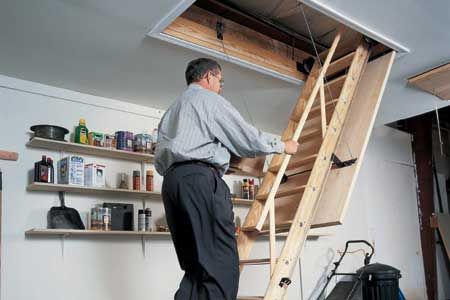Project details
Skill
Cost
Estimated Time
Installing pull-down attic stairs adds easy access to valuable overhead space. Though moderately challenging, this project is achievable for many do-it-yourself (DIY) enthusiasts and can typically be completed in six to eight hours, as long as you have the proper materials. Whether you’re expanding an existing hatchway or creating new attic access, this guide will walk you through the process step-by-step so you’ll be able to install a sturdy, safe, and convenient pathway to your attic.
Things To Note About Pull-Down Attic Stairs
Pull-down attic stairs are a practical solution for homes short on storage space. These staircases are designed to smoothly glide up and down from the ceiling, typically assisted by a system of steel cables and spring-loaded drums. When not in use, the stairs are concealed by a large, flush-panel door, maintaining a clean ceiling appearance. When extended, they provide a comfortable and safe 57-degree angle for easy attic access.
Before beginning the installation, ensure you have sufficient headroom above the attic floor for the staircase to close properly. Additionally, understanding the system’s components, including the door panel, stringers, treads, and pulley mechanism, will help you navigate the installation process more effectively.
Tools and Materials Needed for Pull-Down Attic Stairs
To successfully install pull-down attic stairs, you’ll need a specific set of tools and materials, listed below.
Tools
- Drywall saw
- Drill and drill bits
- Screwdriver
- Hammer
- Tape measure
- Level
- Chalk line
- Wrench set
- Safety glasses and dust mask
Materials
- Pull-down attic stair kit
- 1×8 lumber for framing
- 16d nails or 1/4-inch-diameter, 3-inch lag screws
- Wood screws
- Casing molding
- Paint (to match the ceiling)
Preparing for Pull-Down Attic Stairs Installation
Before you begin installing your pull-down attic stairs, measure the existing hatchway or the area where you plan to install the new attic access. Most pull-down attic stairs require a rough opening of about 22.5 inches by 54 inches, but always check the manufacturer’s specifications for your model. Use a tape measure to mark the dimensions on the ceiling, then snap chalk lines to create a clear outline of the opening.
Before cutting into the ceiling, inspect the attic space above the proposed opening. Look for any potential obstructions, such as electrical wiring, plumbing pipes, or HVAC ducts. If you encounter any of these, you may need to adjust the location of your opening or consult with a professional to safely relocate these utilities.
For additional help installing your stairs, check out this video with Tom Silva installing attic stairs.
Step 1: Cut out the attic access opening
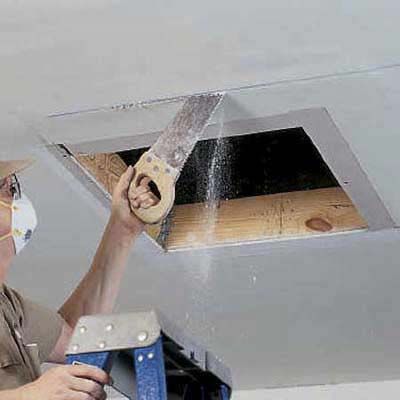
Snap chalk lines onto the ceiling to represent the rough opening of the attic staircase. This step is necessary regardless of whether you’re expanding an existing hatchway or creating new attic access. Peek into the attic to make sure there aren’t any ducts, wires, or pipes in the way. Then cut out the rough opening with a drywall saw.
Step 2: Remove joists and other obstructions
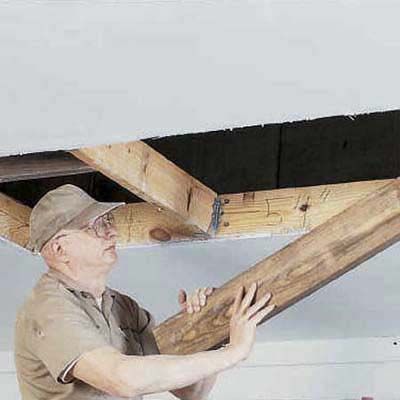
Cut out the ceiling joist and any wood blocking that’s in the opening. Leave the header from the hatchway in place and use it to form one end of the rough opening. Nail a new header between the joists on the opposite end of the rough opening to complete the framing. Secure the drywall ceiling to the new framing with nails or screws driven up from below.
Step 3: Construct the opening frame
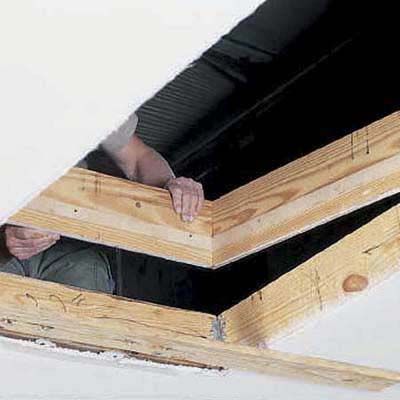
Temporarily screw a pair of 1×3 cleats to the ceiling across the rough opening. Build a finished frame out of 1x8s to fit snugly into the opening. Lower the frame down onto the cleats from above, then fasten it to the framing with 16d nails or 1/4-inch-diameter, 3-inch lag screws. Remove the temporary 1×3 cleats.
Step 4: Mount the door panel
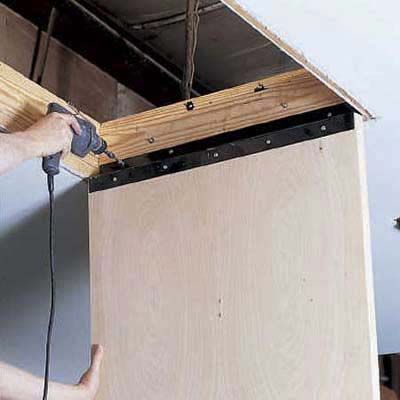
Mount the door panel to one end of the finished frame with the continuous hinge included with the staircase. Check the door’s swing, making sure it closes without binding and fits flush within the frame.
Step 5: Install spring drums
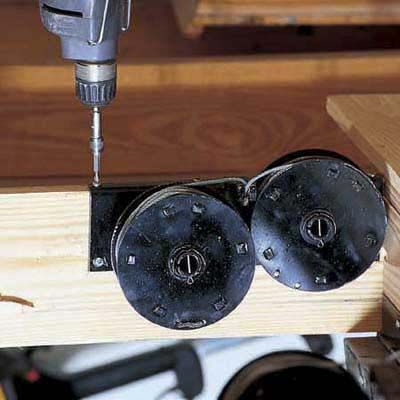
Next, screw the left-hand spring drums to the 1×8 frame directly above the door hinge and up against the header. Mount the right-hand spring drums on the opposite side of the frame. Attach the header-guide frame between the two sets of drums—it will be used later to hold the upper end of the staircase in position.
Step 6: Install pulley system
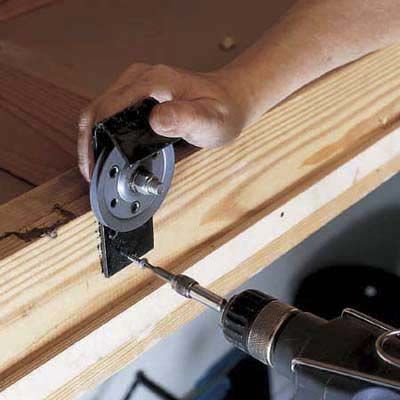
Screw a small cable pulley to each side of the finished 1×8 frame; position each pulley 20 inches from the header that’s opposite the door-panel hinge. Attach each small pulley with three 1-inch-long screws. Bore pilot holes first to avoid splitting the 1×8 frame.
Step 7: Assemble the staircase
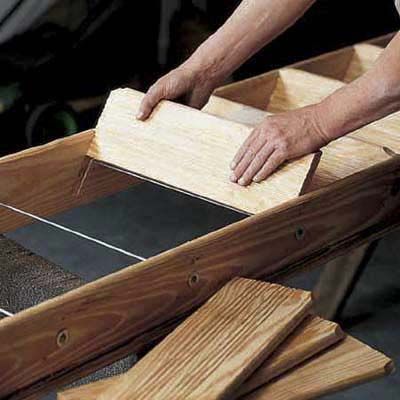
Slip the stair treads into the angled dadoes milled in the two stringers. Secure each pine tread with four screws. Then use a wrench to tighten the threaded ladder rods that pass beneath each tread. Leave out the top three treads so you can easily fit the staircase between the header-guide frame mounted above the door panel.
Step 8: Attach staircase to door panel

Stand the assembled staircase in the opening and have someone support the base as you climb up part way. Grab the top of the stringers and squeeze them in until the slide bars on the header-guide frame slip into the channel grooves on the outside of the stringers. Now install the top three stair treads. Slide the steel door-guide frame onto the staircase, then attach it to the door panel with six 1-inch-long screws.
Step 9: Mount cable holders
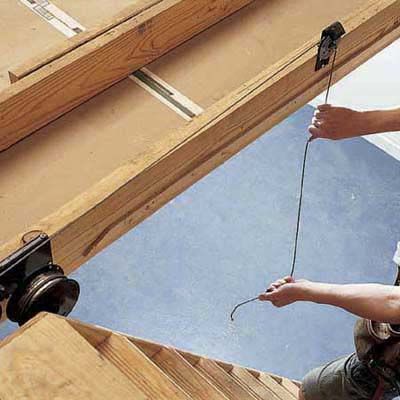
Using the pilot holes located near the fourth tread, mount cable holders to the side of each stringer. Reach up to one of the spring drums, grab the cable closest to the header, and carefully pull it out. Pull the cable across the small pulley and down to the cable holder mounted to the door. Hook the cable end onto the holder. Use the same procedure to connect the cable from the drum on the other side of the stairs.
Step 10: Calibrate tension for a smooth glide
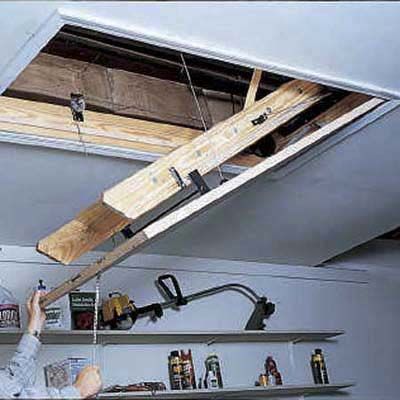
Adjust the tension on the cables until the staircase glides smoothly up into place and closes without slamming shut. If the door doesn’t close all the way, increase the tension by disconnecting the cables, winding them around the spring drums two times, and then reconnecting them. Finish by nailing casing molding around the perimeter of the opening. Lastly, paint it to match the ceiling.
Pull-Down Stairs Safety Considerations
When installing pull-down stairs, ensure that all components are securely fastened and that the stairs can support the weight they’re rated for. Consider adding a full-length handrail for added safety when ascending or descending the stairs. Always follow the manufacturer’s guidelines for weight limits and proper use.
Maintenance Tips for Attic Stairs
After installation, consider adding insulation around the attic stair frame and to the back of the door panel to increase energy efficiency. This helps prevent heat loss through the attic access point, potentially lowering your energy bills.
You should also periodically check all hardware and tighten any loose screws or bolts. Lubricate moving parts, such as hinges and pulleys, with a silicone-based lubricant. Inspect the stairs for any signs of wear or damage, and address issues promptly to prevent accidents. Clean the steps regularly to remove dust and debris, which can cause the mechanism to jam or wear out more quickly. If you notice things are no longer operating smoothly or there are broken parts, you should fix your attic stairs before using them again.
Troubleshooting Common Pull-Down Attic Stairs Issues
Even with proper installation and maintenance, you may encounter some issues with your pull-down attic stairs. Common problems include difficulty opening or closing the stairs, squeaking noises during operation, or the stairs not staying closed. Most of these issues can be resolved by adjusting the tension on the cables, lubricating moving parts, or tightening loose hardware. If you’re unsure about how to address a problem, it’s best to consult with a professional.
Attic Stairs Cost Considerations
The cost of installing pull-down attic stairs can vary depending on several factors. Understanding these can help you budget effectively for your project.
DIY vs. Professional Installation
While DIY installation can save money, it requires time, tools, and a certain level of skill. Professional installation typically costs around $60 per hour, according to HomeAdvisor, but ensures the job is done correctly and safely. If you’re unsure about your ability to complete the installation, it may be worth investing in professional services.
Factors Affecting Price
The cost of pull-down attic stairs can range from about $200 to upwards of $1,000, depending on the quality, materials, and features of the unit. Steel or aluminum ladders will reduce some assembly, but they will also increase the cost. Additional costs may include materials for framing and finishing, as well as any necessary electrical or HVAC work if utilities need to be relocated. The complexity of the installation, such as the need to enlarge an existing opening or create a new one, can also impact the overall cost.
Our Conclusion
Installing pull-down attic stairs makes it easier to access your attic and maximize storage space. While the project requires careful planning and execution, it’s achievable for many DIY enthusiasts with moderate skills and the right tools.
